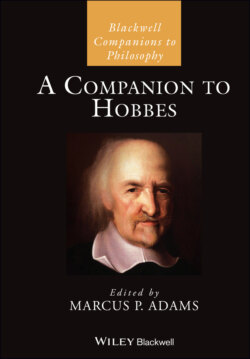Читать книгу A Companion to Hobbes - Группа авторов - Страница 45
3.1.1 Hobbes’s Mathematical Ontology
ОглавлениеA central tenet in Hobbes’s first philosophy is the denial of immaterial substances. As he famously declared in Leviathan chapter 4, “puzzled philosophers” will often “make a name of two names, whose significations are contradictory and inconsistent; as this name, an incorporeall body, or (which is all one) an incorporeall substance” (Hobbes 2012, 60; 1651, 17). This amounts to a declaration that the terms ‘substance’ and ‘body’ are convertible, which entails that any doctrine purporting to deal with a realm of non-physical objects is either arrant nonsense to be dismissed or a confusion standing in need of a fundamental reinterpretation.
In point of fact, mathematics was traditionally understood to be a science whose proper objects are immaterial. The fifth-century ce neo-Platonist Proclus Diadochus summed up the traditional view when he complained that the consideration of matter “muddies” the intellectual apprehension of geometric objects (Proclus 1970, 87). Aristotelians rejected the Platonic concept of a realm of ideal geometric forms, but they nevertheless held that the objects of mathematical investigation must be radically distinguished from the contents of the material world. Christopher Clavius, professor of mathematics at the Jesuit Collegio Romano, summed up the sixteenth-century Aristotelians’ doctrine that mathematics deals with a particular kind of abstract objects that are “considered apart from all matter” or abstracted from any underlying material substrate (Clavius 1612, 1:5). Wallis followed a broadly Aristotelian understanding in his 1657 Mathesis Universalis, proclaiming magnitude to be the object of geometry, adding that “By magnitude I understand lines, surfaces, and bodies taken mathematically, that is, abstracted from matter, whose various affections and properties geometry demonstrates” (Wallis 1693–1699, 1:21).
Where the tradition sought to develop an account of mathematics that makes it independent of the structure or contents of the material world, Hobbes pursued a radically materialistic treatment of the subject. The basis of this program is developed in chapter 8 of De corpore, which bears the title “Of Body and Accident.” In De corpore VIII.4 Hobbes offers a definition of the term ‘magnitude’ with the remark that “The Extension of a Body, is the same thing with the MAGNITUDE of it, or that which some call Real Space” (EW I.105). Having identified magnitude with the extension of body, Hobbes proceeds in De corpore VIII.12 to define the geometric terms ‘point’ and ‘line’ in terms of the central concept of body:
Though there be no Body which has not some Magnitude, yet if when any Body is moved, the Magnitude of it be not at all considered, the way it makes is called a LINE, or one single Dimension; & the Space through which it passeth, is called LENGTH; and the Body it self, a POINT; in which sense the Earth is called a Point, and the Way of its yearly Revolution, the Ecliptick Line.
(EW I.111)
Surfaces and solids are then definable in the same manner. This account of magnitude has an obvious connection to Hobbes’s materialistic ontology. Because he takes only bodies to be real, and because he maintains that it is only through the motion of bodies that anything can be brought about, Hobbes must base all of mathematics on the principles of matter and motion. Mathematical objects must therefore be interpreted as bodies or things produced by the motion of bodies. In particular, the geometric point is a body, which requires that the point be divisible and have magnitude (even if that magnitude is disregarded), while lines, surfaces, and solids arise from the motions of points, lines, and surfaces, respectively.
At first sight, it might seem that there is no place for arithmetic in this scheme. Taking space, motion, and body as fundamental concepts might make tolerable sense of geometry, but it is unclear how this can work for arithmetic. Classical authors drew a firm distinction between the continuous magnitudes of geometry and the discrete “multitudes” of arithmetic. Geometric magnitudes such as lines, angles, surfaces or solids are divisible into lesser magnitudes of the same kind (lines divide into lines, angles into angles, etc.). In contrast, the discrete multitudes of arithmetic were taken to be only finitely divisible and to be ultimately composed from indivisible units. Viewed in this way, geometry and arithmetic are fundamentally different sciences with essentially different objects. Hobbes, however, held that arithmetic could be based on the uniform division of continuous magnitudes into equal parts. As he put the matter, “because any given continuous magnitude can be divided into any number of equal parts, with its ratio to any other magnitude remaining unchanged, it is manifest that arithmetic is contained in geometry” (OL IV.28).
